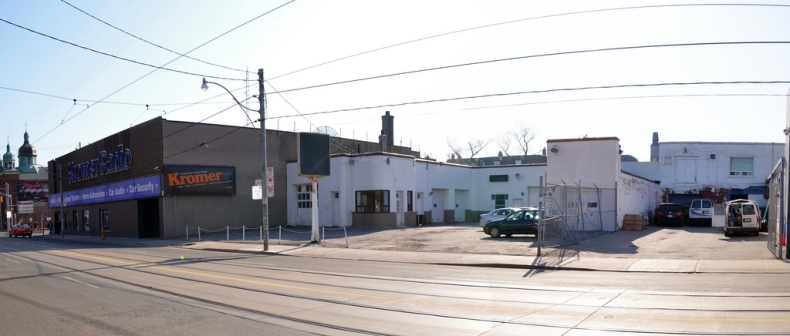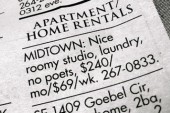
Being a Torontonian who loves Toronto can be trying even at the best of times. At the worst of times it can be downright infuriating as we watch our beloved city, a region with so much potential, dither as our politicians fear our urban future.
City Councillors Mike Layton and Adam Vaughan, both considered to be exemplar progressive politicians, have banded together to do something that I suppose many would classify as progressive. Fearing the construction of a Kensington Destroying Monolith known as ValMart (that’s how you say WalMart in Yiddish — the traditional language of what was once Toronto’s downtown Jewish Market), proposed by developer RioCan for the old Kromer Radio site on Bathurst due west of the market, the ambiguously progressive duo bandied together last Friday to propose a bylaw that, subsequently passed by city council, effectively froze any new retail development along Bathurst Street between Dupont and Queen until a year from now. As stated, the motion is meant, “To preserve the existing scale and character of the street until the Bathurst study is complete, we have put in place this interim control bylaw that will prohibit new retail and service uses as well as additions to existing retail and service uses for a period of one year for the lands on and flanking Bathurst Street, between Dupont Street and Queen Street West.”
As someone who has grown up in Toronto and who regularly takes Bathurst Street to get to work I will be brutally honest — there is no retail character to speak of along Bathurst Street between Dupont and Queen. There are a couple of isolated retail outposts along Bathurst’s northern fringes, where the quaint Barton Snack dishes out ice cream and scones, yet Bathurst, south of local brunch spot The Grapefruit Moon is, for the most part, an unappealing and, to be frank, a rather un-urban streetscape.
“Let’s stroll down Bathurst,” said no Torontonian ever.
There is no need to protect the existing “scale,” because Bathurst’s existing scale — an ugly mix of dilapidated Victorian row houses, parking lots and intermittent shuttered retail — sucks.
To a Toronto that can sometimes be fearful of its own shadow, this Bathurst bylaw is a (small c) conservative act clothed in progressive clothes. Placing an unnecessary moratorium on development is more about the desire by (small c) conservative politicians to protect an outmoded vision that we like to sell to ourselves about Toronto. As Mike Layton would later tell the National Post, “We are trying to protect main streets on Queen Street, Little Italy, Kensington Market and Dundas West by restricting big-box retail.”
Protecting our main streets is a noble cause in some respects. Where would Toronto be without its multitude of urban villages and BIA’s working to support the city’s overall eclecticism? But the cliché that too many of Toronto’s municipal politicians espouse — Toronto, financial heart of Canada and regional population pushing 6 million people be damned, is really just like a quaint village — is not our reality.
“Toronto — just like a bigger Port Hope.”
This is not civic leadership for modern Toronto, this is a stick your head in the sand sort of politics. What all of this talk of “Toronto as a Village” forgets is that the city has allowed the construction of almost 8,000 condo units in City Place, Peter Freed (by my math) has singlehandedly built over 1500 condo units in the eponymous Freedville (King and Bathurst). Throw in other developments in the King West area, as well as inelegantly named Fort York Neighbourhood, currently sprouting at the foot of Bathurst, a city the size of Stratford Ontario has been built between Spadina and Bathurst south of King. This city’s residents are looking to buy toilet paper at a reasonable price (while simultaneously willing to spend a small fortune on hormone free, organic chickens). Toronto is not a village of villages. It is a major urban city yet our downtown politicians are fighting to protect the dilapidated character of what should be a main street LINED with retail (and condos above them) both big box and not.
Awesome.
The fear of big box retail and development along Bathurst misses a really important point: our main streets, such as they are — College, Harbord and now Dundas Street — are lined with award winning restaurants, great bars and other lively places which make-up a the exciting mélange of big city life. But what they don’t contain is soup-to-nuts services, nor do they have the development space for such amenities And it is neither progressive nor urban to deny someone the right to buy toilet paper simply under the chimera of protecting “local” and “independent” retailers. The two are not mutually exclusive.
The fear of big box has been wrapped up in some nonsensical need to protect the Toronto we know and love, the idyllic Toronto of many villages that we sometimes like to pretend is the norm. We cannot “protect” Little Italy, nor Kensington without focusing necessary growth on our alternative arteries like Bathurst. Of all of downtown Toronto’s street Bathurst, with its lack of retail character, presents the perfect opportunity to build new retail space to meet the needs of a growing downtown population, which as a side-note we should be incredibly happy and thankful and proud of the fact that people are clamouring to live downtown.
RioCan’s proposal includes smaller retail units at street level with Wal-Mart occupying the building’s top two floors.This is not to say that unfettered development is the answer — Liberty Village is an example of a village whose big box retail has been poorly integrated with existing heritage buildings. The result is a hodge-podge of strip malls coupled with somewhat walkable streets. But an outright ban on development is not a positive solution; there is little to stop RioCan from going to the OMB to proceed with their development. Leadership, especially the leadership Toronto needs right now, must work with developers to ensure the best possible outcome from development.
There is still an opportunity for this to happen on Bathurst, where the city is performing a Built Form and Land Use Study. The outcome of this study, which should be published in November, will hopefully establish a vision for Bathurst Street that will guide development applications and planning decisions. In many ways this is necessary — unlike Queen Street, where development has been successfully guided by the Queen Street Heritage Conservation District, Bathurst is currently blank slate. It is also a bit of an oddity — a major artery, most of the street is not classified as an “Avenue” in the City’s official plan (Avenues are where the city promotes the development of mid-rise [5-11] story condo buildings with retail at grade), instead the street acts as the official boundary between what the city views as “Downtown” versus the rest of the city.
As a boundary, however, Bathurst is oddly suburban. As the Land Use Study notes 43% of Bathurst’s existing built-form is single family residential. Presumably the report will say this needs to change. The question is whether we’re ready for that change. A flash point of so much current angst, the RioCan development (with its proposed WalMart) is actually shorter than other buildings currently under construction on Bathurst. The Origami Lofts at Queen and Bathurst as well as B Street Condos near Bathurst and Bloor are both taller. And yet the local resident groups, such as the Friends of Kensington Market or the Seaton Village Residents Association, are concerned with preserving the existing scale of Bathurst Street even if the existing scale doesn’t meet the needs of Toronto. As the Seaton Village residents association fearfully notes, “The western side of Bathurst St… has an Avenues designation (problematic in itself, for our little neighbourhood).” Therefore while Friends of Kensington Market (FOKM) may like to tell people that they’re not anti development, one wonders if we’re ready to accept the type of “scary” development that may occur?
Here’s the reality: there will be new retail development along Bathurst in the next five years because it is what an urban city needs. RioCan will develop the Kromer Radio site, moratorium be damned, and a large developer will buy Honest Ed’s. As downtowners we can either work with developers to define what that retail space is going to look like or we can try and protect a city that doesn’t exist anymore simply because we are fearful of its future.
Anne Johnston, a former city councillor from Yonge and Eglinton, was one of the few city councillors who understood the dynamic reality of a changing city. In office during the proposed construction of Minto’s Yonge and Eglinton condo development, Johnston helped facilitate a deal with the developers for significant dollars to be included in affordable housing. Johnston, a Millerite and progressive, was prescient in her understanding that simply protesting change wasn’t leadership.
Johnston, as is now legend, was voted out of office by her own constituents who were angry at her supposed betrayal. Ten years later those much hated Minto towers seem to have receded into the back minds of Torontonians who have moved on to other places to protest. And ten years later the development’s quaint courtyard has actually become a pretty decent focal spot at Yonge and Eglinton.
Bad leaders reject things outright because it’s easier. True leaders work to enact better change. There is no difference between Mike Layton and Adam Vaughan attempting to protect the status quo then suburban politician who argue that they don’t want high rises built in their backyard. Both are not in my backyards of the same sort and both should have no place in a Toronto that is bigger than it thinks it is.
____
Jonathan Naymark is a Toronto-based writer. Follow him on Twitter @naymark.
For more, follow us on Twitter @TorontoStandard and subscribe to our newsletter.














